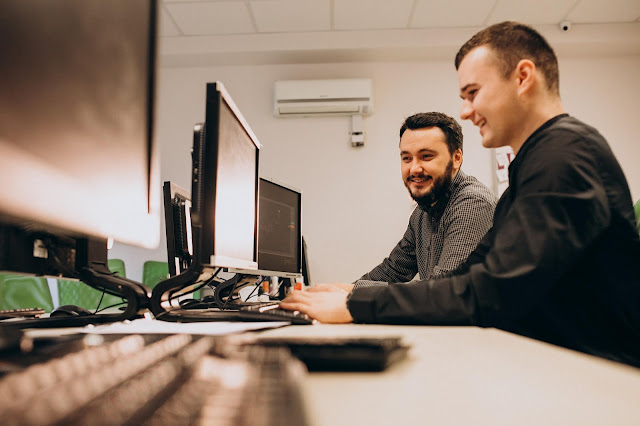Trends In UI/UX Design For 2020
We present the 7 UX / UI design trends that you cannot miss. We anticipate that technological advances such as 5G or new devices will have a clear impact and that some past trends will re-emerge strongly. Ready to discover them?
Trend1: Swiping is the new tapping
It is becoming more common for
new devices to feature larger screens and eliminate physical buttons. The size
of our phones continues to increase and, although everything seems to be
advantages, for designers this becomes a great challenge. The way in which we
hold the mobile phone and the radio that we are able to cover define both the
arrangement of the elements on the screen and the movements that the user can
perform. Because of this, swiping, "gliding", becomes a much more
natural way to use mobile devices, especially if we only have one free hand.
Applications like Tinder have taken this trend to its maximum splendor but we
anticipate that in 2020 many others will.
Trend 2: Dark mode is here to stay
The dark side was never so
elegant" about this trend that will undoubtedly have a great impact in
2020. Some websites and apps have been offering the possibility of activating
the dark mode through its settings for those night owls who want it. However
this year it will no longer be seen only as a one-time mode to reduce eye strain but will be designed considering that many users will use it
continuously as the main mode. In addition to reducing battery consumption,
dark backgrounds will allow design elements to stand out more, creating a
greater ratio of contrasts and offering new visual possibilities.
Trend 3: Gradients and
futuristic colors are back
Before flat design dominated
digital interfaces, gradients were used to create (semi) realistic surfaces.
After a few years where spot colors have predominated, it seems like a
transition from pure flatness to gradient designs is taking place, showing some
depth again. As for colors, futuristic palettes based on neon colors and highly
saturated hues are expected, far from the tones of nature. This is intended to
generate designs that go beyond the screen and contain their own light.
Trend 4: The eternal debate
between flat design vs skeuomorphism
For those of you who are not
familiar with the terms, flat design refers to graphic elements taken to their
minimum in terms of textures and colors. Reliefs, gradients, and any decorative
element that is necessary to convey the message are eliminated. While
skeuomorphism tries to imitate reality, creating digital elements based on the
characteristics and movements of the original elements. Although up to now the
clear winner was flat design, skeuomorphism has regained prominence since the
appearance of Material Design. As a result of this fusion of flat design with
natural physics, the user has a more intuitive understanding of how elements
work on the screen. Objects have weight and inertia when we manipulate them,
they pretend to offer resistance when we slide them across the screen, or they
cast shadows on the elements that are under them. Looking ahead to the new year
we can say that we will continue with Material Design and that we will see an
increase in skeuomorphism, without a doubt, a new reinterpretation of the
concept.
Trend 5: The Year of Overlap
If we can tell you something, it
is that this year will not be the year of order as we know it until now.
Asymmetric design and overlap will have an increasing presence in new apps and
websites. While we are talking about unusual compositions, no element will be
random and both overlays and blanks will be structured and balanced. Soft
shadows and floating elements will create a pseudo-3D effect that we will see a
lot in future designs.
Based also on the superposition
we find another effect that comes with force. It is about the glass effect, a
semi-transparent and blurred appearance that allows you to glimpse elements
behind others. The user experience improves by being able to show various
layers on the same screen without making it difficult to use and read.
Trend 6: Shall we say goodbye to cargo items?
With the arrival of 5G, the speed
of data transfer increases, and thus loading times are reduced. This opens up a
whole new range of possibilities for transition animations and movements.
Animated elements that were previously used to make waiting more enjoyable can
now become a dynamic way to guide the navigation flow. Little by little the
screens and loading elements will disappear as technology advances and will
eventually become irrelevant. However, the animations will remain and will be
used to highlight the interactive elements.
Trend 7: 3D Elements
Finally, introducing 3D elements
will become a widely used trend in 2020. The integration of three-dimensional
elements in flat surroundings will turn applications into a physical space in
which the user feels they can enter. A trend that will be well received in
e-commerce due to its proximity to reality.
Every business needs a proper user
experience for their website or apps so they easily understand and easily
control it. So new trends provide easy usability and accessibility to the end-users. To find out more info about web
design or apps design, contact us at Growthworx



Comments
Post a Comment